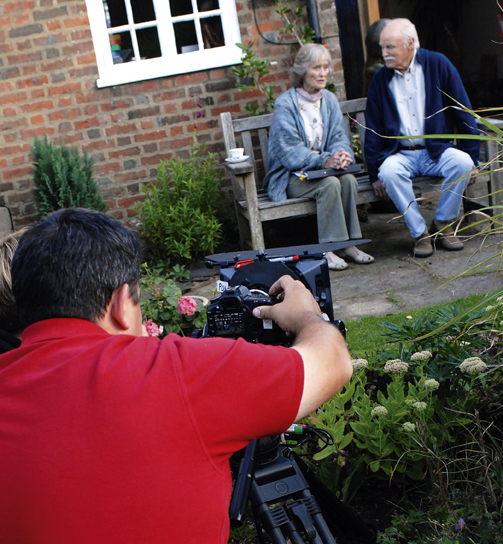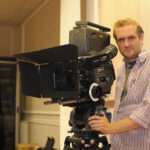
Love Loss
Posted on Jan 1, 2010 by Alex Fice
How do you shoot a movie with a DSLR stills camera? The answer is very carefully and with the knowledge that you have booked a few sessions with a high end DI suite and have a crew that can remember the ‘old school’ ways of shooting
Ever since we started talking about high definition production in HD Magazine we have, most of the time, also mentioned the production in budgetary terms. “We used HD because the budget demanded it”, we have heard this caveat many a time. This semi-apologist approach leaves you feeling that HD may forever be seen as the poor relation to film, even though by and large at the moment that is true.
But there are budgetary cuts and then there are false economies. So when DoP Mark Moreve learned of the £120,000 budget for the feature film Love Loss he might has seen this as a HDCAM + Pro adapter kind of budget, or maybe a RED or possibly Sony EX1 again with adapter. What he didn’t expect was to be persuaded by the director that the best way to go would be to use a DSLR stills camera, the Canon EOS 5D MkII.
“It wasn’t my choice to use the Canon but the director, Guy Daniels, thought it was the best way to go with the budget we had.” The Canon DSLR has indeed made some in-roads to the professional video world but mainly with video promos where sound synch isn’t a worry. The camera has some serious flaws though with it’s lock-in to 30p and it’s total lack of focusing and exposure aids. Also the way it ‘bins’ pixels to produce a H.264 file is brutal and a H.264 post route isn’t workable. Music promos are one thing but a 90 minute feature surely is an economy too far especially as the movie was going to printed to film and premiered at Cannes.
Having thrown all the technical brickbats at the Canon 5D MkII, one of the reasons directors and producers are falling in love with it is its look. Forget all the negatives and take in the glorious depth of field that this bigger than 35mm sized sensor delivers. Mark knew about the 5D Mark II and had one of the first in the country, when it didn’t have control over exposure (A firmware update later allowed this). “I told Guy that this wasn’t feasible as a camera to use. It was only when the firmware upgrade happened that we re-kindled the idea to use it.
“The whole subject and the film’s script did lend itself to using the Canon. One thing we were all really worried about was ‘artifacting’ and is it going to break up a lot if you pan the camera quickly. We talked about that a lot but the script doesn’t call for much movement of the camera.” (The film is about two old aged pensioners meeting after sixty years apart).
Mark shot with his own lenses which were four zooms but no primes (budget again). Lenses were Sigma 15-30mm, Canon 24-70 f2.8, 70-200m f4 and a 100-400m f4.5-5.6. All Canon L Series.
“If I’d had a choice of anything I would have had that Canon 50mm f1.2 and the 85mm f1.2 which is just a ‘light catcher’ it’s incredible.
“You’ve got to be incredibly careful about how you use the depth of field even with a focus puller. There is no point in trying to get depth between a nose and an eyeball all the time. I had to think about that quite a bit.
“We used it (DoF) as much as we can to tell the story because that’s what the joy of that camera was, to have this magic depth of field.
“It’s a timeless look which worked very well with the actors we had. You also have to really careful with this camera with the blacks, they really can crush.”
Don’t Pan The Camera
Guy Daniels is a fan of Ken Loach and David Lynch films where the action is usually contained within the frame without moving the camera to capture it, so worries about the camera lessened the more they analysed it. “Guy wanted to use the camera primarily for budget reasons but was also keen on the depth of field, the general look of the footage. You get 35mm depth of field at the price of a high street DSLR.”
Once the decision had been made to use the 5D MkII Mark had to prepare it for shooting and find a rig that could use it without the compromises winning out, “I had to find a way of using a Mattebox and of course follow focus was massively important, companies like Red Rock and Zacuto haven been really quick on to the market with their accessories but saying all that we finished up using a Chroziel mattebox and I bought a Proaim plate and 15mm rods.
“Unfortunately on the first morning of the shoot I had a Proaim follow focus that snapped so we used a Chroziel one from a friend who happened to live quite nearby. You have to use a cog that attaches to the outside of the stills lenses so you can use the follow focus.
“The biggest problem the focus puller had was the fact that the barrels on the lenses don’t stop, although the focus stops internally, the external barrel on the lens doesn’t stop so you can’t mark up the lens. So a lot of the time he was re-calibrating especially when we were using the 70-200mm lens. He was having to re-calibrate that lens every time we did a lens change. He would literally running out a tape measure, get out the clapperboard, put it at four foot, put it at six foot, eight foot and so on. Our focus puller was a 35mm guy who took this on and went for it. We all came into the project feeling it was a little different but that was half of the excitement.
“The focus puller knew he had these lenses and also knew he wasn’t going to have a confident monitor that so many focus pullers work with these days because of the monitoring situation with the camera. He was going to have to do it ‘Old School’ and do it by eye. He was going to run out a tape measure and make some marks. So many people have a confidence monitor these days.
“Our sound recordist, Jerome McCann, had to work from the script only. He had no monitor which now is unheard of. He recorded the sound at 30 frames, because the camera only records at 30. We did a synch test, where we didn’t even use a DigiSlate, we used a clapperboard. We had to keep on going back to old techniques, there were times when we were outside and because you’ve only got that three inch LCD on the back of the camera I had to wear a blanket over my head. I did that a lot!”
All Mark really wants from this camera is the 24/25p update, (coming 2010) everything else he says is livable with (apart from the monitoring). The post route includes a week’s grade with The Mill which seems to be a very sensible move with their new Data pipeline, but before that all the footage had to be turned in to Apple ProRes 4:2:2 HQ and then in to 24p.
The one huge disadvantage to using this camera, for Mark, is the monitoring. “You need monitors for the director and sound recordist and if you plug a monitor in then the camera’s monitor shuts off. Imagine the scene around that small monitor, director, cameraman, focus puller, costume department, make up, it’s get quite crowded back there!
“Something they all loved though was the zoom function on the back of the camera which could pick up someone’s skin or clothing or even microphones you are trying to hide.”
Love Loss is in post at the moment and will be premiered at the Cannes Film Festival .








